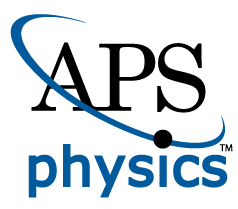http://join2-wiki.gsi.de/foswiki/pub/Main/Artwork/join2_logo100x88.png
Spin-1/2 Kondo effect in an InAs nanowire quantum dot: Unitary limit, conductance scaling, and Zeeman splitting
Kretinin, A. V. ; Shtrikman, H. ; Goldhaber-Gordon, D. ; Hanl, M. ; Weichselbaum, A. ; von Delft, J. ; Costi, T.FZJ* ; Mahalu, D.
2011
APS
College Park, Md.
This record in other databases: 
Please use a persistent id in citations: http://hdl.handle.net/2128/10893 doi:10.1103/PhysRevB.84.245316
Abstract: We report on a comprehensive study of spin-1/2 Kondo effect in a strongly coupled quantum dot realized in a high-quality InAs nanowire. The nanowire quantum dot is relatively symmetrically coupled to its two leads, so the Kondo effect reaches the unitary limit. The measured Kondo conductance demonstrates scaling with temperature, Zeeman magnetic field, and out-of-equilibrium bias. The suppression of the Kondo conductance with magnetic field is much stronger than would be expected based on a g-factor extracted from Zeeman splitting of the Kondo peak. This may be related to strong spin-orbit coupling in InAs.
Keyword(s): J
Note: The authors would like to thank Moty Heiblum for making this work possible and for suggestions and critical remarks made during the work. We also acknowledge Yuval Oreg, Mike Grobis, Nancy Sandler, Sergio Ulloa, and Jens Paaske for fruitful discussions, Ronit Popovitz-Biro for the TEM analysis of nanowires, and Michael Fourmansky for technical assistance. We thank David Logan and Martin Galpin for reading an earlier version of our manuscript and pointing out that the dependence of linear conductance (but not differential conductance) on magnetic field could be understood quantitatively by taking a higher value for g-factor. A. V. K. is grateful to Yunchul Chang for his design ideas and expertise in electronics. This work was partially supported by the EU FP6 Program Grant 506095, by the Israeli Science Foundation Grant 530-08 and Israeli Ministry of Science Grant 3-66799. D.G.-G. acknowledges NSF contract DMR-0906062 and US-Israel BSF grant No. 2008149. T. A. C. acknowledges supercomputer support from the John von Neumann Institute for Computing (Julich).
Contributing Institute(s):
- Theoretische Nanoelektronik (PGI-2)
- Theoretische Nanoelektronik (IAS-3)
- JARA - HPC (JARA-HPC)
Research Program(s):
- Grundlagen für zukünftige Informationstechnologien (P42)
- Thermoelectric properties of self-assembled quantum dots and oxide heterostructure interfaces (jiff23_20100501)
Appears in the scientific report
2011
Notes: http://prb.aps.org/abstract/PRB/v84/i24/e245316
Database coverage:
;


